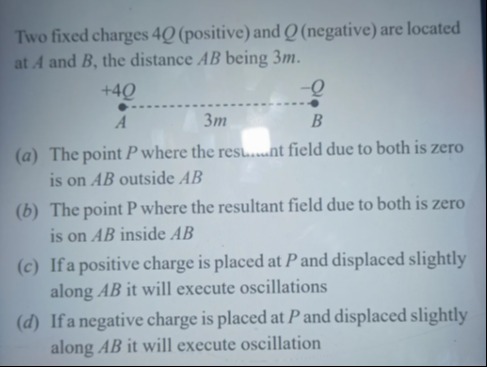Question
Question: Two fixed charges 4Q (positive) and Q (negative) are located at A and B, the distance AB being 3m....
Two fixed charges 4Q (positive) and Q (negative) are located at A and B, the distance AB being 3m.

The point P where the resultant field due to both is zero is on AB outside AB
The point P where the resultant field due to both is zero is on AB inside AB
If a positive charge is placed at P and displaced slightly along AB it will execute oscillations
If a negative charge is placed at P and displaced slightly along AB it will execute oscillation
(a), (d)
Solution
The charges are +4Q at A and −Q at B, with the distance AB = 3m.
First, we find the point P where the electric field is zero. Let P be on the line AB.
If P is between A and B, the electric field due to +4Q is directed towards B, and the electric field due to −Q is directed towards B. Since both fields are in the same direction, the resultant field cannot be zero.
If P is outside the segment AB. Let P be at a distance x from B to the right of B. Then the distance from A is 3+x.
The electric field at P due to +4Q is EA=(3+x)2k(4Q) directed to the right.
The electric field at P due to −Q is EB=x2k∣−Q∣=x2kQ directed to the left.
For the net field to be zero, the magnitudes must be equal:
EA=EB
(3+x)2k(4Q)=x2kQ
(3+x)24=x21
4x2=(3+x)2
Taking the square root of both sides:
2x=±(3+x)
Case 1: 2x=3+x⟹x=3. This is a valid positive distance.
Case 2: 2x=−(3+x)⟹2x=−3−x⟹3x=−3⟹x=−1. This is not a valid positive distance.
So, the point P is located at a distance of 3m to the right of B. Since AB = 3m, P is on the line AB and outside the segment AB. This confirms option (a).
If P is to the left of A, let the distance from A be x. Then the distance from B is 3+x.
The electric field at P due to +4Q is EA=x2k(4Q) directed to the left.
The electric field at P due to −Q is EB=(3+x)2k∣−Q∣=(3+x)2kQ directed to the right.
For the net field to be zero, the magnitudes must be equal:
EA=EB
x2k(4Q)=(3+x)2kQ
x24=(3+x)21
4(3+x)2=x2
2(3+x)=±x
Case 1: 6+2x=x⟹x=−6. Not a valid positive distance.
Case 2: 6+2x=−x⟹3x=−6⟹x=−2. Not a valid positive distance.
So, the point P is to the right of B.
Thus, the point P where the resultant field is zero is on AB outside AB. Option (a) is correct. Option (b) is incorrect.
Now consider the stability of equilibrium at P. Let the point P be at x0=6 (assuming A is at x=0 and B is at x=3). The electric field at a point x on the line is E(x)=x2k(4Q)−(x−3)2kQ for x>3.
Consider a small displacement δx from P, so x=x0+δx=6+δx.
E(6+δx)=(6+δx)2k(4Q)−(3+δx)2kQ
For small δx, we can use Taylor expansion or binomial approximation.
E(x)=k(4Q)x−2−kQ(x−3)−2
E′(x)=k(4Q)(−2)x−3−kQ(−2)(x−3)−3(1)=−8kQx−3+2kQ(x−3)−3
At x=6, E′(6)=−8kQ(6)−3+2kQ(6−3)−3=−8kQ/216+2kQ/27=−kQ/27+2kQ/27=kQ/27.
Since Q>0, E′(6)=kQ/27>0.
The force on a test charge q0 is F(x)=q0E(x).
For a small displacement δx from equilibrium x0, F(x0+δx)≈F(x0)+F′(x0)δx.
Since F(x0)=0, F(x0+δx)≈F′(x0)δx=q0E′(x0)δx.
The condition for stable equilibrium is that the force is a restoring force, i.e., F(x0+δx) and δx have opposite signs.
q0E′(x0)δx<0.
q0(kQ/27)δx<0.
If a positive charge is placed at P, q0>0. Then (kQ/27)δx<0. Since kQ/27>0, we need δx<0. This means if displaced to the right (δx>0), the force is to the right, which is unstable. If displaced to the left (δx<0), the force is to the left, which is also unstable. So, for a positive charge, the equilibrium is unstable. Option (c) is incorrect.
If a negative charge is placed at P, q0<0. Then (kQ/27)δx>0. Since kQ/27>0, we need q0δx>0. Since q0<0, we need δx<0. This means if displaced to the right (δx>0), the force is to the left (restoring). If displaced to the left (δx<0), the force is to the right (restoring). So, for a negative charge, the equilibrium is stable. If displaced along AB, the force is proportional to the displacement for small displacements, so it will execute oscillations. Option (d) is correct.
